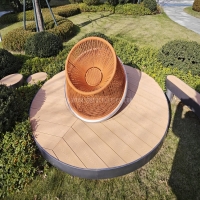Welcome to the website for landscape facilities products and knowledge.
Are there any recommended weight distribution guidelines for the table in uneven terrains?
When setting up tables on uneven terrain, proper weight distribution becomes crucial for stability and safety. Unlike flat surfaces, sloped or irregular ground requires strategic planning to prevent tipping accidents and ensure functional use.
Begin by assessing the terrain's slope and identifying the table's most stable orientation. For portable tables, position the heaviest items—such as equipment or food containers—directly over the table's legs rather than at the edges. This lowers the center of gravity and reduces tipping risk. On moderate slopes, place more weight on the downhill side while maintaining overall balance to counter gravitational pull.
For permanent installations, consider using adjustable leg levelers or shims beneath the table legs. These allow precise compensation for ground irregularities while maintaining even weight distribution. When dealing with significant unevenness, create a stable foundation first using platforms or compacted gravel before addressing weight placement.
The 60/40 rule often applies to uneven terrain setups: distribute approximately 60% of total weight toward the more stable, supported areas while keeping 40% on the less supported sections. This prevents overloading vulnerable areas while maintaining functionality. Always test stability with gradual weight application before full use, and regularly check for shifting during extended outdoor events.
Remember that weight distribution alone cannot compensate for severely unstable foundations. Combine these guidelines with proper site preparation and quality equipment designed for outdoor use to achieve optimal results across various terrain conditions.
Related search:

Recommendation
Swivel chair-Specialty steel structure woven rattan leisure chair with rotatable design